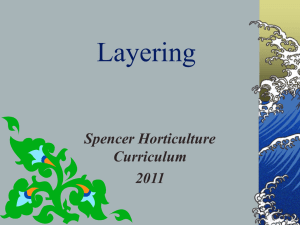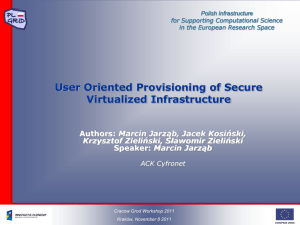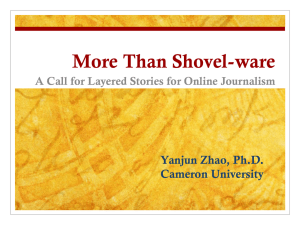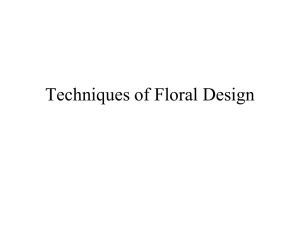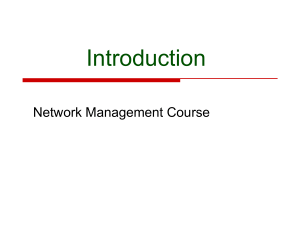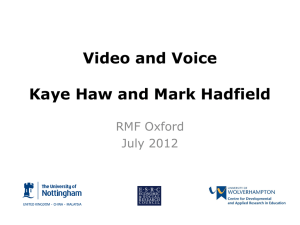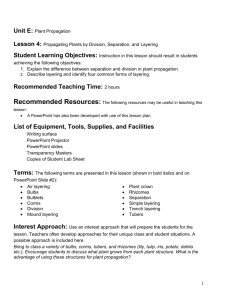The politics - Effective States
advertisement
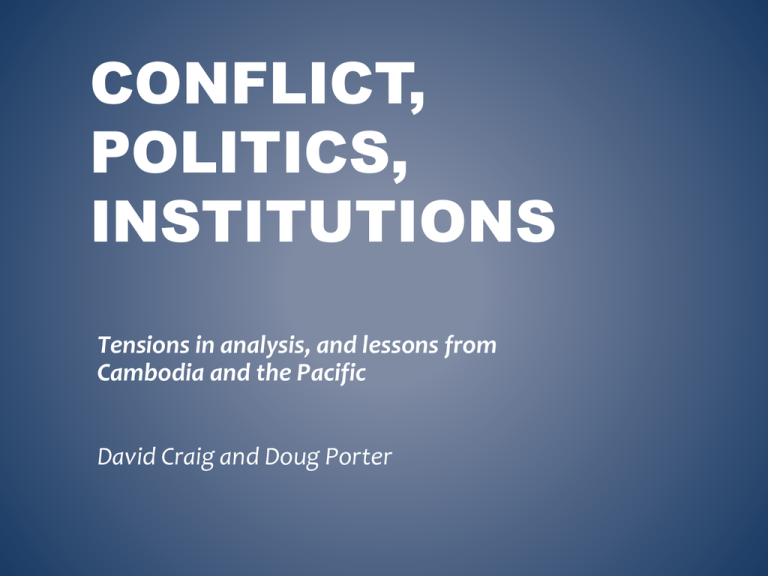
CONFLICT, POLITICS, INSTITUTIONS Tensions in analysis, and lessons from Cambodia and the Pacific David Craig and Doug Porter TENSIONS IN POLITICAL AND INSTITUTIONAL ANALYSIS OF POST CONFLICT ARRANGEMENTS • Normative/ Instrumental • Critical • Positive • ESID: ‘What kind of politics can help secure inclusive development, and how can these be promoted? • ‘…an ‘adapted political settlements ‘ approach that draws in important insights from the broader realms of political theory, and particularly from more critical approaches’ BASIC CLEAVAGES IN ANALYSIS: POLITICAL ECONOMY AND INSTITUTIONAL APPROACHES • Whether the political settlement/ economy that matters is structurally antecedent and super-ordinant to the pacting and its institutionalisation • Or whether the pacting and its institutionalisation can constitute a real rupture, and generate subsequent, predictable change in the basic political settlement via incentivised agency – Temporal questions, but also related to scale, agency and limits of impact (layering) – The wider question of whether instrumentalisation is possible – ESID (and us) wanting to work across these tensions COMBINING POLITICAL ECONOMY AND INSTITUTIONAL PERSPECTIVES IN POSITIVE/ CRITICAL ANALYSIS? • Khan: elites and rents; institutional formality and informality • Slater: ‘infrastructural grasp’ of elites, and the basic nature of the pact (protection and provisioning), stable vs fragmented outcomes • Hickey: political settlement and open access orders, located within wider critical accounts of hegemony, political economy MID-LEVEL POLITICALINSTITUTIONAL CAPABILITIES ANALYSIS Basic structuration meets NI: Capabilities (‘grasp and reach’) and agency Pacting context: protection and provisioning (Critical) political settlement/ economic context modalities/ rules/ executive function roles/ enrolments/ relationships/ political agency rents/ resources/ finances WINNING THE PEACE IN CAMBODIA: MIDLEVEL LOGICS OF TRANSLATION, EVASION, LAYERING, HYBRIDITY • • • • • • • A 25 year retrospect of a decentralisation / local development programme: ‘Seila’ ‘Poverty reduction and environmental protection through good governance’ How the program’s modalities were translated into Cambodian contexts How the programme was co-opted, adapted and imitated by enrolled political actors trying to settle politics Protection and provisioning contexts; Comparative grasp and reach of modalities and resources How ‘multi-hat wearing’ actors (local and international) were enrolled by neoliberal contracting modalities and wider assemblages Longer term institutional layering issues: something which tried to coordinate but ended up layering/ evading NOT YOUR TYPICAL NATION STATE SEGMENTARY SOCIETIES THE SOLOMONS IN CONFLICT INTERVENTION: RAMSI THREE MID-LEVEL LOGICS OF POST CONFLICT INSTITUTIONAL CAPABILITY IN SOLOMON ISLANDS • Geopolitics and the primacy of provisioning • Ethnic cleavage, clientage and transactionalisation of pacts • Institutional co-production, evasion and layering POLITICALINSTITUTIONAL CAPABILITY LOGIC 1: GEOPOLITICS AND THE PRIMACY OF PROVISIONING • Dispersed constituencies, central political pacts • Weak party/ pact enrolment: dissolution of governments through confidence votes • Urban primacy, central and local rents • Weak modality reach: enormous problems in provisioning, and in expressing political agency through government machineries POLITICALINSTITUTIONAL CAPABILITY LOGIC 2: ETHNIC CLEAVAGE AND THE TRANSACTIONALISATION OF PACTS • Problems of elite cohesion, protection and concessionary provision • Clientage, security and elite provisioning • Cash nexus transactions seeking enrolement across the ethnic divide • The transactionalisation and monetisation of elite political economic pacts POLITICALINSTITUTIONAL CAPABILITY LOGIC 3: COPRODUCTION AND LAYERING • Co-production: massive international presence in security, justice, health and education, public finance • Political agency/ enrolment eroded in mainstream public provision and resourcing • Channelling resources into modalities where they can be used to enrol political support: Constituency Development Funds • Ongoing raiding of co-produced budgets for new layered capabilities SUPERORDINANT STRUCTURE VS INTERVENTION AGENCY? NOVEL STRUCTURATIONS VIA INSTITUTIONAL LAYERING • Institutional outcomes are not set in stone by political economy (but retrospect will show that political economy contained many, many clues, especially as to predisposing institutional capabilities) • Outcomes emerge, intended and unintended, over time, and in a range of temporal relations of capability reinforcement or corrosion, evasion and adaptation • Layering can and does produce surprising results over time: fragmentation, but also hybridity and places for ‘multi-hat wearers’ and political actors to hide, adapt , learn, reform 1. POLITICAL ECONOMY AS ANTECEDENT • The politics/ political economy that matters is antecedent to the pacting and its institutionalisation • Macro/ deterministic focus on – The nature of the (political) economy, the nature and scale of production, the kinds of rents available – Macro focus on the nature of Political and economic geography, scale, ethnic divisions, political and economic elites and their alliances 2. INSTITUTIONAL CHANGE AND HOW IT HAPPENS SUBSEQUENT TO INTERVENTION • Whether the pacting and its institutionalisation can constitute a real rupture, a reforming moving, a change in the basic political settlement – Classic Historical Institutional analysis of critical juncture, path dependency, cycles of return – New Institutional analyses of incentives, transactions, rational acting, open and restricted access orders – Instrumentalised political approaches: social accountability, g7+ New Deal pactings, imagined sequencings OUR ANALYSIS • Analytic framings that can work across different levels of scale and temporal framings – up to and down from political economy and its timeframes – down into everyday institutional/ modality arrangements and their transformational outcomes in intervention timeframes, and from there back up into political economy • Mid level logics, placed in locations, that combine political economy and institutional processes • Empirical and other engagement with programmes on the ground, especially in post conflict subnational governance/ justice
